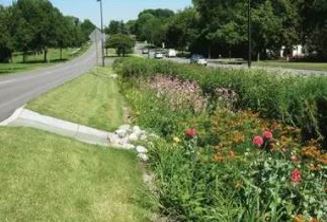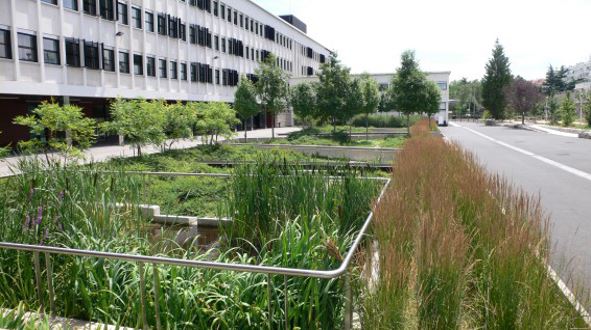In urban areas, rainwater falls and runs off mineralized surfaces (asphalt, concrete, bitumen, etc.). For cities, this generates problems in terms of:
- water pollution: instead of being absorbed by the soil, rainwater is loaded with pollutants from the leaching of the impermeable surfaces on which it runs;
- flooding, due to an excessive volume of runoff water that can clog up the existing sewage system.
This is why there are integrated rainwater management techniques at the plot level, which improve water quality and reduce the volumes and flows discharged into the networks.

Rain garden. Source: URBAN GreenUP project
A rain garden is a shallow basin designed to collect, store, filter and treat runoff water. To optimize its functions, it should include a mixture of porous soils, native vegetation and some hyper-accumulative plants capable of phytomediation. This type of design is more or less complex, ranging from a simple sunken garden at the foot of a house to an earthwork system managing water from a stream. It should also be noted that, depending on the definition, the rain garden can cover vegetated landscaping such as ditches, valleys or basins (wet or dry).

A rain garden can take the form of a series of planted basins, as seen here in the redesigned courtyard of the Lycée Saint Exupéry, Lyon, France. Source: Cerema
In terms of mitigation, the rain garden allows for carbon storage at the plant level, thanks in particular to photosynthesis which transforms carbon dioxide into organic matter. It should be noted that if we reason in terms of carbon footprint, like any development project, the construction of the rain garden may generate GHG emissions (earthworks, travel generated by the site, etc.), potentially offset by the carbon stored throughout the development.
In terms of adaptation, the rain garden contributes to cooling urban spaces and therefore to reducing heat island effect and overheating zones. The rain garden creates small wetlands, which have a cooling effect through water evaporation and evapotranspiration from the plants.
Whatever its form or size, the rain garden has many co-benefits:
- in terms of water resources: managing rainwater in a localised, economical way and as much as possible independently of underground networks;
- in social terms: giving visibility to the natural water cycle in an educational approach, improving social cohesion (gender, minority group);
- in terms of biodiversity: promote biodiversity in urbanised areas;
- in terms of health (well-being): improving the living environment by associating water and plants, providing relaxation and well-being.
Comments ()